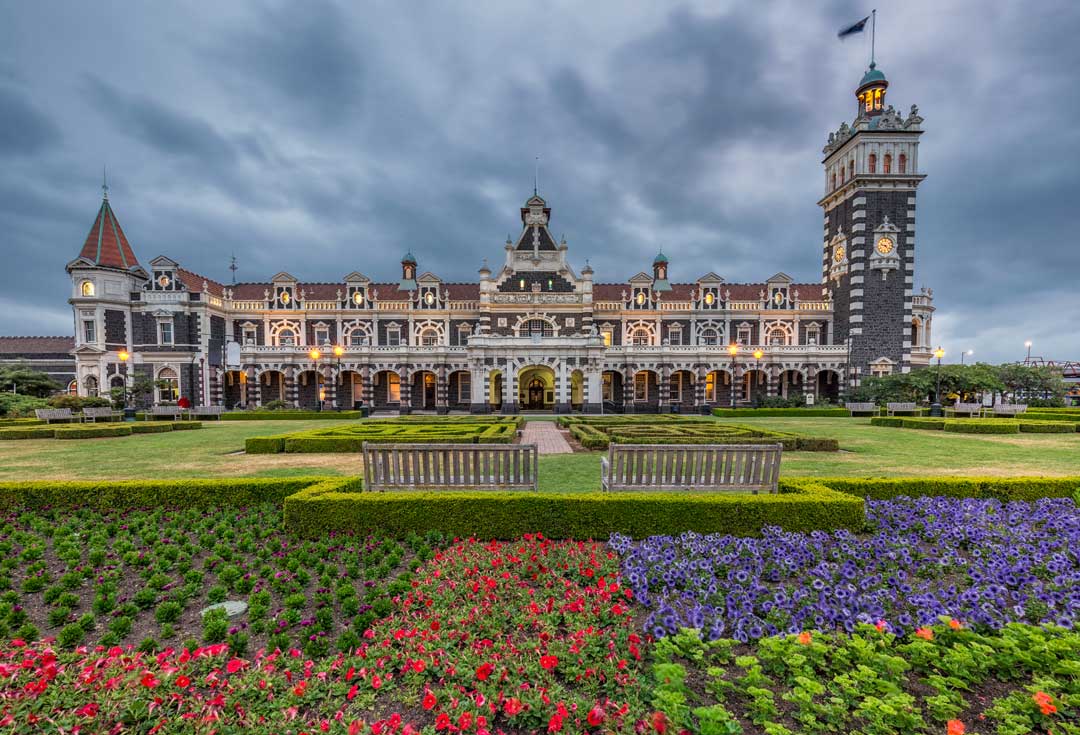5 Things to do in Dunedin
|
1. Consider the Architecture During the Gold Rush of the 1860s, Dunedin quickly became the largest city in the country, and early architecture has survived with some lovely Victorian and Edwardian houses through the older areas of the city. Olveston is a beautifully presented homestead completed in 1906 and gifted to the city in 1966 after the last family died unmarried. Fletcher House, built by Sir James Fletcher in 1909 for the local postmaster, is a restored Edwardian villa furnished in the Edwardian style. From the same era is the 'gingerbread house' style at Dunedin Railway Station. Matanaka Farm Buildings are the oldest surviving farm buildings in the country, dating from the 1840s, and include a granary, schoolhouse, 3 seat privy, storehouse and stables with a gig-room and harness room as well as the stalls. Standing in solitude on the Otago Peninsula is Larnach Castle, New Zealand's only castle. Taking 200 workers more than 3 years to build, the Castle exterior was finished in 1871, with another 12 months to complete the interior. Over the years, the castle has had many faces, from being a lunatic asylum, a retreat for nuns and a hospital for soldiers suffering from battle fatigue. Abandoned and vandalized several times, the ballroom was once used as a sheep pen, but now with restoring, is a lovely stately café. Today the Castle is surrounded with picturesque gardens and 'Alice in Wonderland' statues. St Paul's Cathedral is another architectural masterpiece, and a visit to the Speight's Brewery Ale House built in 1876 is a must.
Otago is home to the world's rarest penguin, the Yellow-eyed penguin which can be seen at the Penguin Place. The world's smallest penguin, the Blue Penguin nests in the cliffs in Pilot Bay on the Otago Peninsula, and may be viewed at the Royal Albatross Centre at Taiaroa Heads. Albatross is also viewed from the same area, with tours throughout the day. At the Korokonui Ecosanctuary, 307 Ha are ring-fenced with predator-proof fencing and enhanced with the re-introduction of rare and endangered species. Birds, fish, Geckos, Butterflies, Trees, Lichen and Tuatara are all present and loved here. Seals and Sea-lions are frequently seen on Aramoana Beach, north of Dunedin, and on spots around the Otago Peninsula. The New Zealand Sealion is one of the rarest seals in the world with a population of only about 12,000.
Otago Museum is a bundle of fun for kids and adults. The hands-on aspects of the museum will keep you entertained for hours. Apart from the exhibitions and galleries, there is the Perpetual Guardian Planetarium with a 360-degree theatre showing films about the Universe, sailing the Pacific, the night sky, aliens and flying monsters. The Toitu Otago Settlers Museum has over 100,000 artefacts that tell the story of settlers from the earliest days to recent arrivals. From the earliest Maori settlers through the Europeans, and Chinese during the First Fleets and Gold Rush, Toitu covers them all. One of only three in the world, the Dunedin Gasworks Museum is sited in the original Gasworks building that was in operation from 1863 to 1987, the first and last gasworks in New Zealand. For a chocolate lovers delight, visit the Cadbury's Chocolate Factory for an hour-long tour where you learn about the history of chocolate and Cadburys, how chocolate is made and new flavours are brought into the market. You even get to taste!
Dunedin has a number of walks whereby views of the city and the surrounding countryside can be enjoyed. Through the streets of the city itself, there is a street art trail, with gigantic artworks creating a supersized art display. To get an overall vista of the city, the Pineapple Track up Flagstaff Hill is an option. The edge of an extinct volcano, Flagstaff Hill was once where the flag was flown when a ship entered the harbour. For another panoramic view of the countryside, Signal Hill offers access for walkers as well as cars and bikes. For a bit of fun, a walk to secluded Tunnel Beach is accessed by an abandoned railway tunnel, just a kilometre from the road to the beach.
Dunedin has a number of scenic rail tours that will live in your memory forever. The most famous is the Taieri Gorge with a choice of two destinations, Pukerangi or Middlemarch. The Gorge is deep and necessitates the train passing through ten tunnels and a number of bridges and viaducts. The engineering of the line is impressive, and the natural environment is matchless. Three other rail journeys follow the coastline north, finishing at Waitaki, Moeraki and Oamaru in turn. Waitaki is at the northern end of the Otago Harbour, Moeraki a beach further north, and Oamaru a town 113km from Dunedin. Oamaru is famous for the white stone quarried, and Moeraki has some colossal boulders that are an incredible sight.
Drive-up the steepest street in the world, Baldwin Street with a gradient of 1:2.8. There are 34 streets in Dunedin with a gradient of more than 1:60.
Architecture Olveston Gardens FOC Guided tour Adult $20.50 Child $11.50 Fletcher House $10 pp Matanaka Farm FOC Larnach Castle Adult $31 Child $10 Speights Brewery Tour Adult $29 Child $13 Animals Blue Penguin Tour Adult $35 Child $10 Penguin Place Adult $54 Child $16 Classic Albatross Tour Adult $50 Child $15 Orokonui Ecosanctuary Discovery Adult $19 Child $9.50 Museums Otago Museum FOC Planetarium Shows Adult $10 Child $7 with 3D $2 extra Toitu Otago Settlers Museum FOC Gasworks Adult $5 Child FOC Cadburys Chocolate Factory Adult $22 Child $16 Rail Journeys Dunedin via Taieri Gorge to Pukerangi from $91 Dunedin via Taieri Gorge to Middlemarch from $113 Waitaki Seasider from $50 Moeraki Seasider from $99 Oamaru Seasider from $109 More articles you may like:
|



